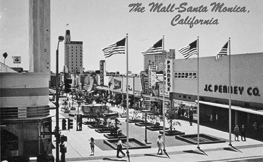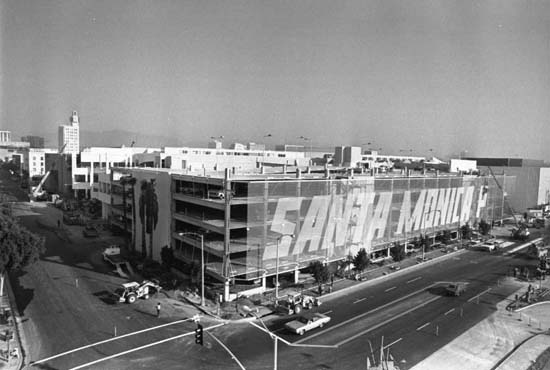By Jorge Casuso
First of two parts
September 17, 2009 -- Given its wild success – the 10 million annual visitors and nearly $300 million in annual sales - it's hard to believe that the three-block stretch called the Third Street Promenade was created by an unlikely coalition of insightful property owners and wide-eyed radicals who followed no discernable plan.
The “formula” for the success of the Promenade, which celebrated its 20th anniversary Wednesday, was that it followed no formula. It was an improvised work that countless cities across the country have tried to emulate, always with limited success.
 |
| Third Street was already a dead street when the City turnind it into the Santa Monica Mall in 1965. |
For the Promenade was born of board members brainstorming and pulling names out of a hat, and residents throwing themselves on the floor and playing with toys, and members of the public voting for the art they’d like to see. And miraculously, it all came together to forge what has become a world-renowned destination.
“There was no formula, there was no model, no benchmark to measure this against,” says former Mayor Dennis Zane, who was the council liaison to the Third Street Development Corporation, the predecessor of the Bayside District.
“In some fashion, we stumbled into success,” Zane says on a recent weekday afternoon as he sits at an outdoor café on the Promenade. “We had to improvise.”
Property owner Ernie Kaplan, who had been tapped to chair the board of the new non-profit corporation launched 25 years ago, agrees.
“They (the City officials) really didn’t know what they wanted,” says Kaplan, who owns the building that houses Barney’s Beanery, which is bustling on this weekday afternoon with lunchtime customers. “We had no idea where this thing would go.
“You had all these loose parts,” Kaplan says. “Some of it was by design, and some of it was by shear luck. We grew into this thing.”
If there was no blueprint to follow, at least one thing was clear – despite its location just a few blocks from the ocean in the heart of Downtown, Third Street was not only struggling, it was dying.
 |
The Santa Monica Mall's success was short-lived. |
The outdoor mall had been declining since the street was closed to cars in 1965 to encourage shoppers to stroll the three blocks between Broadway and Wilshire Boulevard renamed the Santa Monica Mall. Over the next few years, six public parking structures would be built on 2nd and 4th streets in hopes the crowds would come.
The opening drew nationwide attention, but in no time, the novelty had worn off. “It lasted six to eight months,” says John Jalili, who became City Manager in 1984. “They came for the groundbreaking, and they never came back.”
The outdoor mall went into further decline after the Frank Gehry–designed Santa Monica Place opened just south of Broadway in 1980. By the time City Hall took action three years later, the street had become a blighted row of struggling shops and vacant storefronts. Owls were said to roost on the roofs. People joked you didn’t go there at noon.
 |
Santa Monica Place would siphon business from Third Street. |
“It had become a no-man’s land, out of sight, out of mind,” says Margaret “Peggy” Curran, who was then the City’s director of Community and Economic Development.
“It was very quiet,” Zane recalls. “There was nobody here at night. Nobody except a few homeless. All over America downtowns were dying and being replaced by shopping malls.”
Says Kaplan: “This was a toilet. You didn’t want to walk there after dark. There were no lights. You feared for your life.”
THOUGH THE PROBLEM was clear, no one had an answer. The City didn't have the big subsidies needed to lure the large chain retailers that could turn an area around or empty land to offer them. Besides, in-door, climate controlled malls like Santa Monica Place had become all the rage.
“We talked to every retailer in the country, and they all said, ‘You have to enclose the space,’” says Curran, who is now city manager of Tiburon, California. “We weren't buying that. This was Southern California. We went against all the advice we got on that.”
If the City didn’t have the cash, the property owners, who felt the dying Santa Monica Mall had been forced on them by City Hall, were suspicious, Jalili recalls. “Nobody wanted to sacrifice any of their properties.
“We didn’t have a redevelopment district,” Jalili says. “When you don’t have redevelopment, you don’t have money. We were looking at incentives and innovative ideas.”
 |
No one could imagine the wild success the Promenade would have. |
In April 1983, Santa Monicans for Renters’ Rights (SMRR) – which had sponsored a rent control initiative in 1979 that had changed the local political landscape – had gained control of the City Council, and the group was young and hungry and eager to try fresh ideas.
SMRR’s leaders, including Zane, a founder of the group, had written a paper on “third sector institutions,” the name for non-profit corporations then popular in Northern Europe. They had recently gained a foothold locally with Community Corporation, a non-profit housing provider in Los Angeles.
“The reason to do a non-profit was to de-politicize the process,” Zane says. “The non-profit made sure there was strong business leadership.”
But it was one thing to write a position paper, it was another to enlist the support of Santa Monica landlords, many of whom mistrusted a government they thought had trampled over property rights with rent control. And it was the property owners who would have to pay the assessments to help build and operate the new street.
Jalili’s predecessor, John Alschuler, who had worked to regenerate dying downtown districts in the South, had already visited Kaplan when Council member Zane dropped by the landlord’s office in 1983. Kaplan not only owned a building on the Promenade and another one on 2nd Street, he had been buying up and revitalizing old buildings across Los Angeles.
“Denny came into my office to see if I was politically motivated, and there I was as a-political as could be,” Kaplan recalls. “The only way this was going to work is if it’s not political. When he encouraged people like me to get involved, it legitimized him to the people who owned property.”
Kaplan wasn’t the only property owner Zane and the City enlisted. Also signing on were Ed Wenner, whose son Jann had co-founded Rolling Stone magazine, and Bill Janss, whose family created Westwood and the surrounding area after donating the land for UCLA to the state.
“The train comes through the station once every 25 years,” Kaplan says, “and either you get on the train or you miss it. People said this is a potential gold mine. We just didn’t know how much.”
With the property owners on board, the City officials were ready to try something different. “I was extremely enthusiastic about doing something radical,” Curran says.
Part 2: The Everyone agreed something radical needed to be done. But what?